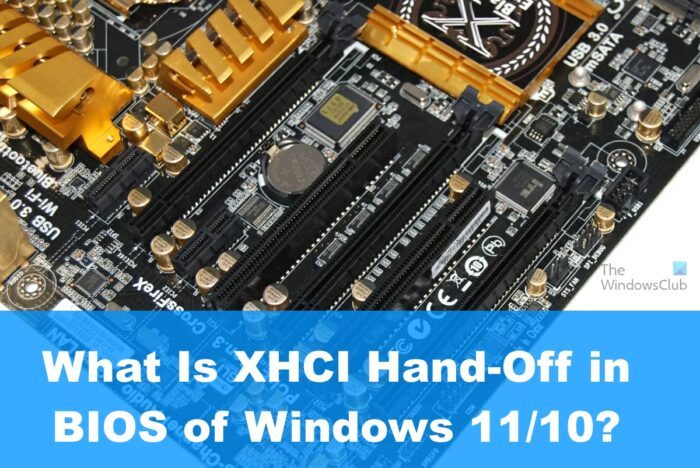Have you ever heard of XHCI Hand Off? Chances are you haven’t, but it is something that exists in the BIOS configuration of your Windows 11 computer. Some users may have come across it after booting into the BIOS of their computer, but have no idea what it is and its overall purpose.

Now, we must note that not every computer comes with the XHCI Hand Off, so if you check your BIOS and fail to find it, you should not worry because this is common.
Let us discuss more deeply about what XHCI Hand Off is all about, and whether or not you should enable or disable it.
What is XHCI Hand-Off in BIOS?
XHCI Hand-Off is a feature that controls how your USB 3.0 port works on your computer. You see, when the XHCI Hand-Off mode is enabled and up and running, your USB 3.0 ports will function as a typical USB 3.0 port. However, if the feature is disabled then the USB 3.0 ports will effectively transform into USB 2.0 ports.
This means, whenever you attempt to transfer data, the speed will be similar to that of a USB 2.0 port, and that’s quite impressive if you ask us.
We should point out that for computers running Windows 11/10, the XHCI Hand-Off is automatically turned on. However, if you choose to downgrade to Windows 7, 8, or even Vista, then the feature will be disabled by default. It will then be up to you to manually enable it from the BIOS settings.
From our understanding, the majority of motherboards right now tend to have more than one SHCI handoff mode, and this is something that depends on the availability of the driver along with the overall motherboard functionality.
As stated, there are several modes, but we want to discuss the most popular two of the bunch, and they are as follows:
- Auto XHCI handoff: When it comes down to auto mode, your USB ports will act as USB 2.0 ports until the correct USB 3.0 drivers are installed in the BIOS. Once the driver is installed, you are required to reboot the computer to establish USB 3.0 as the default going forward.
- XHCI handoff smart mode: In terms of smart mode, it is very similar to auto mode in some respects. You see, it works the same as the auto mode when booting the Windows computer. However, we should point out that when a restart takes place, the BIOS takes note of the reboot and keeps the relevant drivers loaded in system memory. This ensures that the USB 3.0 ports will never deprecate to USB 2.0 on boot, and that’s a great addition from our point of view.
XHCI vs EHCI
There aren’t many differences between both technologies outside of the USB version they support. You see, XHCI is linked with USB 3.0, while EHCI supports USB 2.0. So, as it stands, XHCI is more advanced, due to supporting a higher version of USB, but not for anything else.
Now, it should be noted that XHCI is primarily seen on 100 series motherboards and higher, which correlates significantly with the 6th generation and higher of Intel processors.
READ: How to fix USB 3.0 slow transfer speed in Windows
Should xHCI hand off be enabled?
Enabling XHCI hand off depends on what you want for your computer. If you require USB 3.0 functionality, then enable it in haste. However, if your operating system of choice is Windows 7 or earlier, then you should disable it if you want faster input.
READ: USB Composite Device is an older USB device and might not work with USB 3.0
How do I turn off XHCI on an HP computer?
For those who want to turn off XHCI on an HP-branded computer, then please go ahead and shut down the device. Press the power button after, then be sure to click on the F10 key to enter the Setup area. From there, ensure that you select Advanced, then Device Options. Finally, you must enable USB EHCI to debug to disable the XHCI controller.